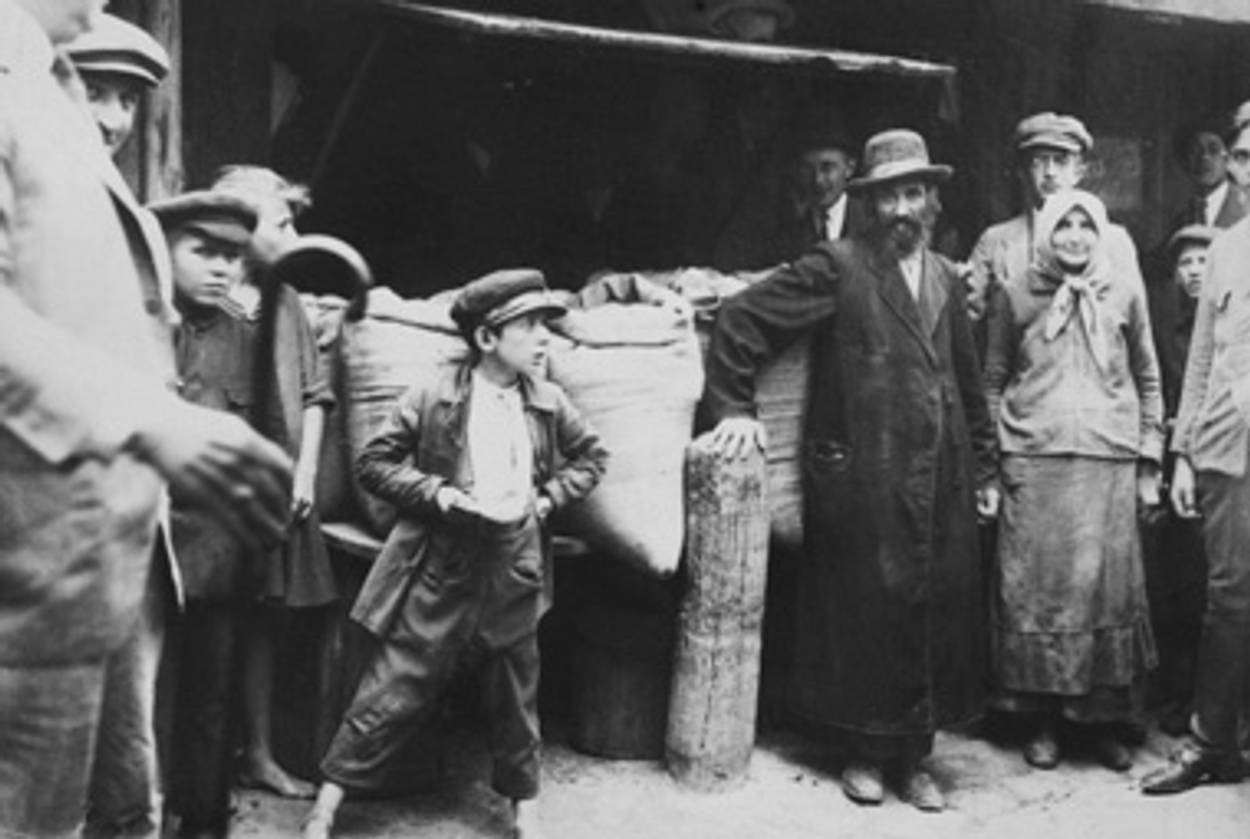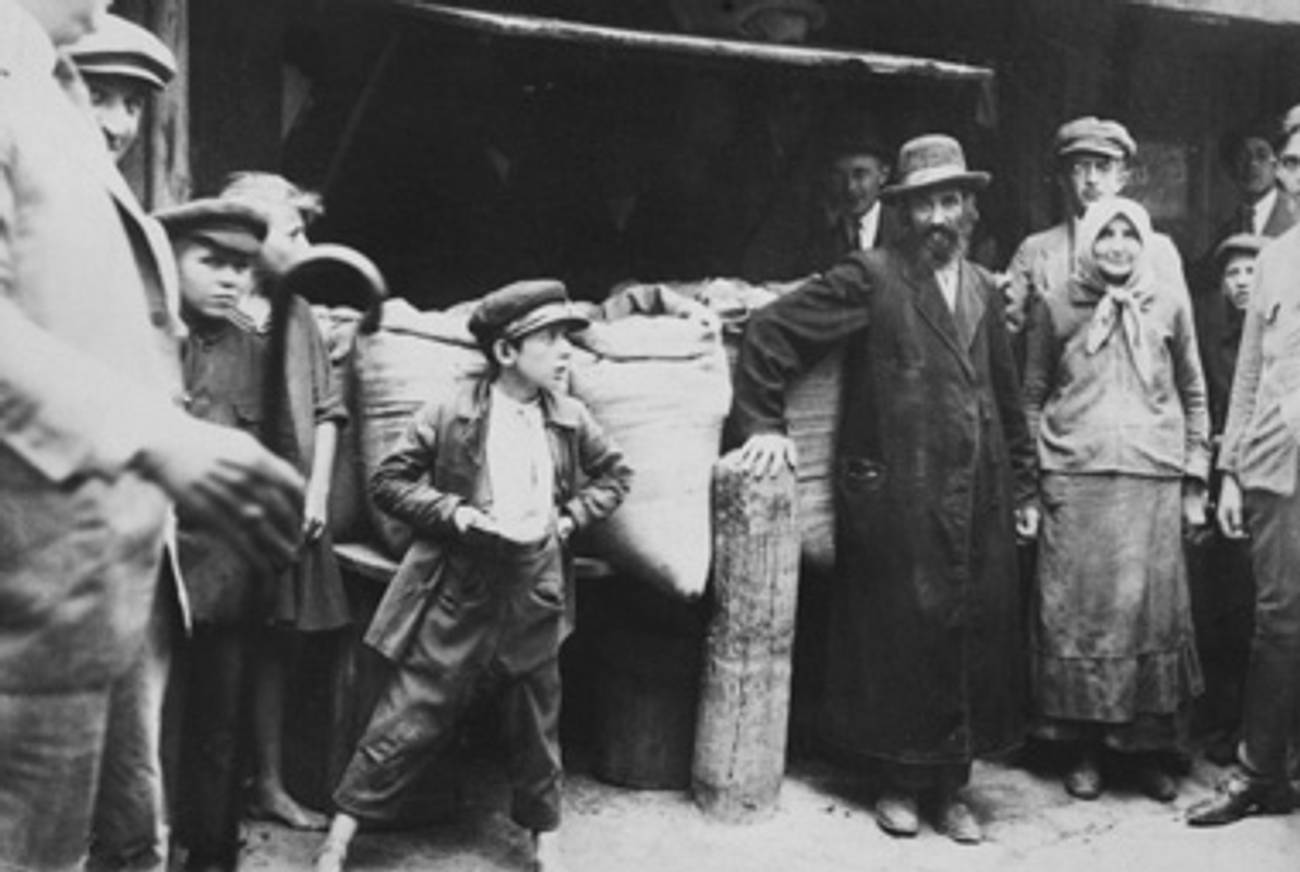Vanishing Act
A new Holocaust history focuses on the life—and death—of the Polish shtetl




In the opening pages of his masterful new study, The Death of the Shtetl, the Israeli historian Yehuda Bauer has harsh things to say about the way American Jews remember their ancestors. “In the nineteen-forties and after World War II,” Bauer writes, “unrealistic, saccharine nostalgia took over remembrance of the shtetl, as manifested in the well-known musical Fiddler on the Roof…. In this sickeningly sweet, made-up world of Eastern Jewry, all Jews were deeply religious, naïve, and clever, and the shtetl was a place where goodness and ethical uprightness ruled despite the difficult conditions.” The American Jew might respond, in his defense, that this sort of romanticizing of the Old Country is common to all American immigrant groups—the Irish tend to remember Ireland and the Italians Italy in much the same condescendingly idealized way as the Jews remember Eastern Europe. We might add that, unlike other immigrant groups, American Jews can have no living link with their ancestors’ world; there are no old homes to visit or distant cousins to meet (or if there are, they are in Israel or the United States by now). Finally, the way in which the old Jewish world was destroyed, in the Holocaust, means that there is a powerful temptation to seek refuge in affectionate legends or pious martyrology—anything rather than face the hard truth that the Jews of Eastern Europe were ordinary people, who lived difficult lives until they died unimaginable deaths.
But the truth is the historian’s business, and a historian of the Holocaust, like Bauer, is used to imagining the unimaginable. “Real events that happened in real time can, with a great deal of effort, be reconstructed,” Bauer writes in his preface. “The events happened to real people, whose stories must be heard and analyzed.” That is Bauer’s goal in this short book, which keeps a narrow focus on one under-researched aspect of the Holocaust: the experience of the shtetls of eastern Poland between 1939, when they were occupied by the Soviet Union, and 1944, when the Red Army returned to find the shtetls completely destroyed. It may sound odd of Bauer to claim that not enough is known about this subject, since there seems to be no end to the writing of books about the Holocaust. But the question that interests him, he makes clear, is not the motives and actions of the Germans, or the mechanics of the Holocaust. “We know that the Jews were murdered—for that we do not need more research,” he writes. What we do need to learn, rather, is “how the Jews lived before they were murdered, [and] what were their reactions in the face of the sudden, unexpected, and, for them, inexplicable assault on their lives by a power whose policies they did not and could not understand.”
The Death of the Shtetl does not claim to be a complete answer to those questions. One of its strengths is Bauer’s readiness to admit when he is baffled—by lack of evidence, or by the impossibility of finding patterns in the evidence. The methodological problems in writing the history of the shtetlach at the end of their existence are, of course, enormous. Almost all of the Jews who had lived in shtetls—which Bauer helpfully defines as not villages but towns, with Jewish populations ranging from 1,000 to 15,000—were killed during the World War II, mostly in 1941 and 1942. Contemporary written documents are almost nonexistent. There were thousands of survivors, and very many of them recorded their testimonies; but their stories are, by definition, exceptions, not the rule. In addition, Bauer points out, survivors were usually “people with a middle-class background and not … the vast majority of the poorer members of the Jewish population,” for the simple reason that “people with more property or wealth” were at an advantage “when they tried to find hiding places in the forests or with peasants who wanted to be paid for the food they supplied.”
In the face of these obstacles, Bauer limits his focus to one region of Jewish Eastern Europe: the marches, or kresy, of eastern Poland. Of prewar Poland’s 3.3 million Jews, 1.3 million lived in the kresy, 60 percent of whom lived in shtetlach. Bauer’s chosen region contained no large cities, so the experience of the Jews of Warsaw and Vilna, with their urban ghettos, is not part of his book. Even more significant, the kresy were the part of Poland that bordered on the Soviet Union, and the region had an extremely troubled geopolitical history. Before World War I, the area had been divided between the Austro-Hungarian and Russian Empires; when the empires disappeared and the region was fought over in a series of murderous invasions and civil wars, as Soviet Russia, Ukraine, and Poland each tried to assert control.
By the 1920s, the area had been incorporated into Poland, but the residual nationalist hatreds were intense. In the kresy, Poles were in a minority, struggling with Belorussians and Ukrainians to define the region’s culture and allegiances. What all these groups had in common was anti-Semitism, both the traditional kind based on religious, cultural, and economic conflicts, and a new nationalist and racist kind that drew inspiration from Nazi Germany. By the 1930s, the life of Jews in the shtetlach was already a different universe from Fiddler on the Roof: they were living in what Bauer calls a “failed state,” suffering from the global fallout of the Great Depression, and deeply worried about the future.” There was no easy way to escape the shtetl,” Bauer writes, “and almost everyone wanted to escape.” One result was that shtetl life became intensely politicized, with Zionists urging emigration to Palestine and socialists urging revolution. But Palestine, under British rule, was closed to Jews, and the Polish socialist parties held their Jewish comrades at arm’s length.
This prolonged crisis came to a dramatic end in September 1939, when the Germans and the Soviets, according to a secret agreement, divided Poland between them. Where the Germans took control, as in Warsaw, killing and ghettoization of Jews began immediately, though the Holocaust itself was still to come. But the kresy fell to the Soviet sphere, and there the situation was more complex—and in some ways, Bauer writes, more troubling. The Communists were hostile in principle to Jewish communal life, and immediately broke up the shtetl’s Jewish institutions. But Soviets were also opposed, in theory and at this point usually in practice, to anti-Semitism, and they brought access to a new culture and what looked like a new economic model.
Most important, the Jews often welcomed the Soviets as protectors against Germany and against their Ukrainian and Belorussian neighbors. Some shtetlach built triumphal arches to greet the Red Army, and in the town of Baranowicze “people kissed the soldiers’ dirty boots.” More surprising is that the Jews acquiesced in the Sovietization of their lives: Hebrew schools and yeshivas were closed, holidays were no longer observed, Bibles and prayer books were banned, and “most synagogues became clubs, cinemas, storage places, and the like.” Significantly, however, many Jews continued to keep kosher, since they could do so at home, in private.
“So a rich ethnic and religious tradition, which had developed into a distinct culture over many centuries, collapsed like a house of cards within a few weeks,” Bauer writes. “Can totalitarian regimes eradicate cultures that easily? This is a frightening and worrying thought.” He offers a few explanations of why the Soviets were so successful in erasing Jewish life in the shtetl—the economic situation, the threat of Nazism, the promise of an end to anti-Semitism—but he concludes, here as elsewhere, that “I am not at all satisfied with my own explanations. I am deeply worried as a Jew by the ease with which Jewish culture was destroyed by a totalitarian regime with both attractions and existential threats.”
What would have happened to the shtetl in the long term, under Soviet rule, is impossible to know. In June 1941, Germany invaded the Soviet Union, and cultural threats were replaced by physical destruction. As promised, Bauer devotes little space to the killing of the shtetls’ Jews, simply noting that, in most places, the Jews were rounded up and shot in a series of major “actions” between summer 1941 and late 1942. The murders were carried out by a combination of German and local—Polish, Ukrainian or Belorussian—units, and the hostility of the surrounding population meant that it was virtually impossible for the Jews to resist or flee. There was simply no place to go.
Anyone who has wondered why—in a question much asked after the war, above all by Jews—the Jews of the shtetlach did not “fight back” need only read Bauer’s account of what happened in Tuczyn, on September 24, 1942. When German and Ukrainian soldiers surrounded the town, the head of the Judenrat called a meeting and advised the Jews to burn the ghetto and run for the nearby forest. Most did so—many Jews, including the rabbi, chose to jump into the flames—and some 2,000 people managed to run away. In the following days, most of the women and children were caught by the Ukrainians and killed with axes and pitchforks. Others starved, or returned to Tuczyn to look for food and were killed there. Sixty men tried to form a fighting unit but couldn’t find any partisans in the area. At the end of the war, Bauer says, 20 survivors emerged from the forest: 1 percent of the original escapees. In Poland in 1942, resistance was as futile as passivity.
That only began to change in 1943, as the Germans were beaten back by the resurgent Red Army. The Soviets managed to establish effective partisan units in the forests and marshes of the kresy, and while many of these were themselves brutally anti-Semitic, they offered at least a shred of hope for the few thousand Jews who had managed to survive until then. Bauer devotes fascinating chapters to the partisans—including the famous Bielski group, featured in the recent movie Defiance—and to the few heroic neighbors, many of them pious Christians, who helped and hid Jews. He sheds much light on the dark subject of the Judenräte, the Jewish Councils that tried to run the shtetlach and ghettos under Nazi rule, showing that their leaders included both villains and heroes.
But in the end, Bauer comes to the conclusion, unsettling for the historian and for readers of history, that these stories do not show any kind of pattern or lead to any conclusion. One shtetl collapsed in despair while another, superficially no different, found the strength to practice what Bauer calls Amidah or “standing up”—cultural resistance and self-help. Some Judenrat leaders were thieves and collaborators, while others helped organize resistance, and still others committed suicide rather than hand over Jews to be killed. Some Ukrainians hid and fed Jews, at great risk to themselves and their families, while others informed on hidden Jews or killed them for their possessions. In the face of such randomness, Bauer writes, “I believe that we have to take recourse to explanations that may sound unusual coming from a professional historian[:] character, chance, and luck.” Which may be another way of saying that, while we can record the death of the shtetl, we can never really understand it.
Adam Kirsch is a poet and literary critic, whose books include The People and the Books: 18 Classics of Jewish Literature.
Adam Kirsch is a poet and literary critic, whose books include The People and the Books: 18 Classics of Jewish Literature.